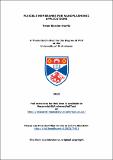Flexible membranes for nanoplasmonic applications
Abstract
Nanoplasmonics has provided a way to control light with extremely high precision, into nanoscale volumes. In many circumstances, the nanoplasmonic devices which can be realised are fabricated using processing techniques which rely on planar technologies.
This thesis provides a general method to make nanoplasmonic devices on a flexible membrane structure, which can be free standing, extremely thin (less than the wavelength of visible light), but retains the ability to be manipulated without loss of optical function. These devices are very pliant and conformable. Flexibility allows the integration of nanoplasmonic devices into many new applications where curved surfaces or the ability to conform to another object is required, as well as providing a route for post-fabrication tunability. Two specific applications are considered: lab-on-fibre technology and surface enhanced Raman spectroscopy.
Lab-on-fibre technologies have been advancing the ability to miniaturise experiments which would normally require a whole laboratory. Fabricating a membrane and then later applying it to the fibre decouples the choice of fibre from the design of the device. Surface enhanced Raman spectroscopy is a powerful diagnostic tool which can uniquely identify an optical fingerprint of different molecules. The technique has been held back from widespread clinical adoption because of the difficulty of reproducibility of the substrates used. A repeatable and reliable rigid substrate is demonstrated, which can identify the concentration of a three component mixture of physiologically relevant biomolecules. This same design is then shown in a flexible form factor, which is applied to a non-planar landscape where it can identify the locations where a molecule of interest has been deposited.
This thesis details the development of the fabrication protocol, the construction of experimental apparatus for characterisation, and the use of numerical modelling to advance the flexible nanoplasmonic membrane platform.
Type
Thesis, PhD Doctor of Philosophy
Collections
Items in the St Andrews Research Repository are protected by copyright, with all rights reserved, unless otherwise indicated.

